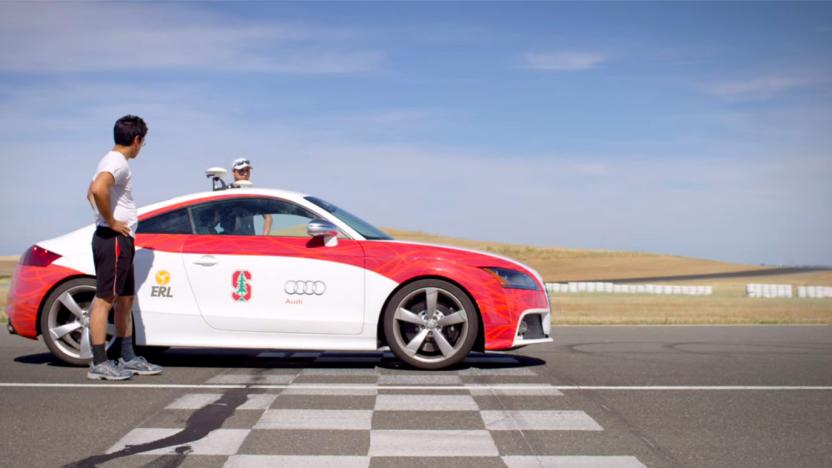AudiTTS
Latest

Watch Stanford's self-driving Audi hit the track
Sending a self-driving race car around a track with nobody inside seems pointless -- there's no driver to enjoy the ride, and the car certainly isn't getting a thrill out of it. But the students performing research with Stanford University's Audi TTS test rig "Shelley" (not to be confused with Audi's own self-driving race cars) are getting a kick out of the numbers generated by the machine. "A race car driver can use all of a car's functionality to drive fast," says Stanford Professor Chris Gerdes. "We want to access that same functionality to make driving safer."

Autonomous Audi TTS scales Pikes Peak in 27-minute climb
They said they'd do it, and by golly, it's been done -- a specially-equipped Audi TTS drove the entire 12.42 miles and 156 precarious turns of the Pikes Peak International Hill Climb without a driver at the wheel. (Google, eat your heart out.) While the vehicle technically performed the feat about a month ago in September, Audi decided to wait until this last week to proclaim it to the world, following a helicopter accident during filming that sent pilot Jim Dirker to the hospital. Thankfully, he survived to fly another day, and at least some of the footage pulled through as well; you'll find a brief clip after the break of the shiny white Quattro autonomously speeding up that hill.

Stanford builds robotic Audi for racing, robotic Volkswagen for parking
You can make a robotic car, and you can make a robotic car -- and it looks like Stanford is leading the charge on the no compromises approach with its new driverless Audi TTS. That, of course, is only the latest in a long line of robotic cars from the folks at Stanford, and it looks like it's also by far their most ambitious, as it's going above and beyond the usual DARPA challenges in the hope of breaking a few records and winning a few races. In fact, the car apparently already holds the "unofficial" speed record for an automous car at 130 miles per hour and, in the long term, Stanford hopes that it'll be able to complete the Pikes Peak International Hill Climb, which stretches some twenty kilometers and includes no less than 156 turns. To balance all that adreneline, the Volkswagen Automotive Innovation Laboratory at Stanford has also developed a new VW Passat "valet system" that may not win any races, but can sure do some mean parallel parking. Videos of both after the break, more details a few hands-off impressions courtesy of BotJunkie at the links below. Read - BotJunkie, "Stanford's New Robotic Audi TTS Knows How To Drift, Will Tackle Pikes Peak Next Year" Read - BotJunkie, "VAIL Demonstrates Autonomous Valet Parking System"

